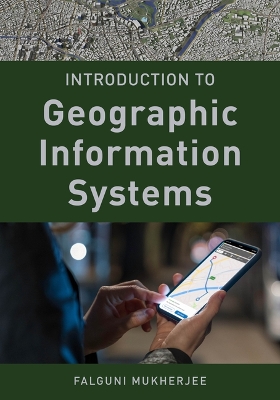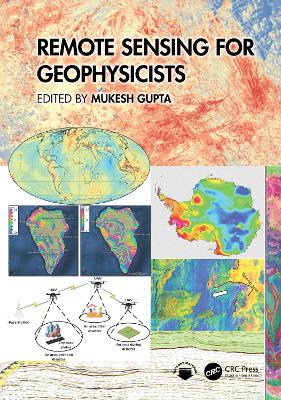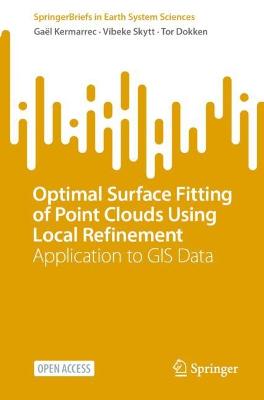Introduction to Geographic Information Systems
 portes grátis
portes grátis
Introduction to Geographic Information Systems
Mukherjee, Falguni
Rowman & Littlefield
01/2025
256
Dura
9781538152003
15 a 20 dias
Descrição não disponível.
Acknowledgments
Chapter 1: What is GIS?
Learning Objectives
Why GIS?
What is GIS?
Components of a GIS
Location Information
A GIS Integrates Information
Processes Performed by a GIS
History of GIS
Questions and Activities
Key Terms
References
Bibliography
Chapter 2: Projections and Coordinate Systems
Learning Objectives
Location Information
Cartography and Maps
Shape of the Earth
Map Projections
Coordinate Systems
Universal Transverse Mercator Coordinate System
The Military Grid Coordinate System
United States National Grid
State Plane Coordinate System
Other Systems
Questions and Activities
Key Terms
References
Chapter 3: GIS Spatial Data Models
Learning Objectives
Representing Real World Features
Vector Data Model
Vector Data Model Structures
Raster Data Model
Comparing the Two Spatial Data Models
File Formats
Questions and Activities
Key Terms
References
Chapter 4: Attribute Data
Learning Objectives
Representing Aspatial Data and Information
Database Management System
RDBMS and GIS
Types of Data
Functions in an Attribute Table
Questions and Activities
Key Terms
References
Chapter 5: Geospatial Data
Learning Objectives
Geospatial Data
Finding Geospatial Data
Field Methods and Geospatial Data Creation
Global Positioning System (GPS)
Remote Sensing Data Collection
Geocoding
Questions and Activities
Key Terms
References
Chapter 6: GIS and Cartography
Learning Objectives
Why Cartography?
Cartographic Elements of a Map
GIS Maps
Questions and Activities
Key Terms
References
Chapter 7: GIS Softwares
Learning Objectives
GIS Softwares
ArcGIS
QGIS
GRASS GIS
gvSIG Desktop
Software Selection
Questions and Activities
Key Terms
References
Chapter 8: GIS and Society
Learning Objectives
GIS and Society - Why?
GIS and Organization - Principles of GIS Project Management
GIS and Society
Questions and Activities
Key Terms
References
Chapter 9: GIS - Possibilities and the Future
Learning Objectives
The World of GIS
What Can You Do with a GIS Degree?
What Lies Ahead?
Questions and Activities
Key Terms
References
Chapter 10: Geospatial Data Analysis
Learning Objectives
Geospatial Analysis - What and Why?
Retrieving Data
Spatial Analysis Using Vector Data
Spatial Analysis Using Raster Data
Questions and Activities
Key Terms
References
About the Author
Series Page
Glossary
Chapter 1: What is GIS?
Learning Objectives
Why GIS?
What is GIS?
Components of a GIS
Location Information
A GIS Integrates Information
Processes Performed by a GIS
History of GIS
Questions and Activities
Key Terms
References
Bibliography
Chapter 2: Projections and Coordinate Systems
Learning Objectives
Location Information
Cartography and Maps
Shape of the Earth
Map Projections
Coordinate Systems
Universal Transverse Mercator Coordinate System
The Military Grid Coordinate System
United States National Grid
State Plane Coordinate System
Other Systems
Questions and Activities
Key Terms
References
Chapter 3: GIS Spatial Data Models
Learning Objectives
Representing Real World Features
Vector Data Model
Vector Data Model Structures
Raster Data Model
Comparing the Two Spatial Data Models
File Formats
Questions and Activities
Key Terms
References
Chapter 4: Attribute Data
Learning Objectives
Representing Aspatial Data and Information
Database Management System
RDBMS and GIS
Types of Data
Functions in an Attribute Table
Questions and Activities
Key Terms
References
Chapter 5: Geospatial Data
Learning Objectives
Geospatial Data
Finding Geospatial Data
Field Methods and Geospatial Data Creation
Global Positioning System (GPS)
Remote Sensing Data Collection
Geocoding
Questions and Activities
Key Terms
References
Chapter 6: GIS and Cartography
Learning Objectives
Why Cartography?
Cartographic Elements of a Map
GIS Maps
Questions and Activities
Key Terms
References
Chapter 7: GIS Softwares
Learning Objectives
GIS Softwares
ArcGIS
QGIS
GRASS GIS
gvSIG Desktop
Software Selection
Questions and Activities
Key Terms
References
Chapter 8: GIS and Society
Learning Objectives
GIS and Society - Why?
GIS and Organization - Principles of GIS Project Management
GIS and Society
Questions and Activities
Key Terms
References
Chapter 9: GIS - Possibilities and the Future
Learning Objectives
The World of GIS
What Can You Do with a GIS Degree?
What Lies Ahead?
Questions and Activities
Key Terms
References
Chapter 10: Geospatial Data Analysis
Learning Objectives
Geospatial Analysis - What and Why?
Retrieving Data
Spatial Analysis Using Vector Data
Spatial Analysis Using Raster Data
Questions and Activities
Key Terms
References
About the Author
Series Page
Glossary
Este título pertence ao(s) assunto(s) indicados(s). Para ver outros títulos clique no assunto desejado.
ARC-GIS;cartography;cloud-based software;digital world;Geographic information science;geographic information systems;geography;geospatial data;GIS;GIS ethics;maps;Online GIS;remote sensing
Acknowledgments
Chapter 1: What is GIS?
Learning Objectives
Why GIS?
What is GIS?
Components of a GIS
Location Information
A GIS Integrates Information
Processes Performed by a GIS
History of GIS
Questions and Activities
Key Terms
References
Bibliography
Chapter 2: Projections and Coordinate Systems
Learning Objectives
Location Information
Cartography and Maps
Shape of the Earth
Map Projections
Coordinate Systems
Universal Transverse Mercator Coordinate System
The Military Grid Coordinate System
United States National Grid
State Plane Coordinate System
Other Systems
Questions and Activities
Key Terms
References
Chapter 3: GIS Spatial Data Models
Learning Objectives
Representing Real World Features
Vector Data Model
Vector Data Model Structures
Raster Data Model
Comparing the Two Spatial Data Models
File Formats
Questions and Activities
Key Terms
References
Chapter 4: Attribute Data
Learning Objectives
Representing Aspatial Data and Information
Database Management System
RDBMS and GIS
Types of Data
Functions in an Attribute Table
Questions and Activities
Key Terms
References
Chapter 5: Geospatial Data
Learning Objectives
Geospatial Data
Finding Geospatial Data
Field Methods and Geospatial Data Creation
Global Positioning System (GPS)
Remote Sensing Data Collection
Geocoding
Questions and Activities
Key Terms
References
Chapter 6: GIS and Cartography
Learning Objectives
Why Cartography?
Cartographic Elements of a Map
GIS Maps
Questions and Activities
Key Terms
References
Chapter 7: GIS Softwares
Learning Objectives
GIS Softwares
ArcGIS
QGIS
GRASS GIS
gvSIG Desktop
Software Selection
Questions and Activities
Key Terms
References
Chapter 8: GIS and Society
Learning Objectives
GIS and Society - Why?
GIS and Organization - Principles of GIS Project Management
GIS and Society
Questions and Activities
Key Terms
References
Chapter 9: GIS - Possibilities and the Future
Learning Objectives
The World of GIS
What Can You Do with a GIS Degree?
What Lies Ahead?
Questions and Activities
Key Terms
References
Chapter 10: Geospatial Data Analysis
Learning Objectives
Geospatial Analysis - What and Why?
Retrieving Data
Spatial Analysis Using Vector Data
Spatial Analysis Using Raster Data
Questions and Activities
Key Terms
References
About the Author
Series Page
Glossary
Chapter 1: What is GIS?
Learning Objectives
Why GIS?
What is GIS?
Components of a GIS
Location Information
A GIS Integrates Information
Processes Performed by a GIS
History of GIS
Questions and Activities
Key Terms
References
Bibliography
Chapter 2: Projections and Coordinate Systems
Learning Objectives
Location Information
Cartography and Maps
Shape of the Earth
Map Projections
Coordinate Systems
Universal Transverse Mercator Coordinate System
The Military Grid Coordinate System
United States National Grid
State Plane Coordinate System
Other Systems
Questions and Activities
Key Terms
References
Chapter 3: GIS Spatial Data Models
Learning Objectives
Representing Real World Features
Vector Data Model
Vector Data Model Structures
Raster Data Model
Comparing the Two Spatial Data Models
File Formats
Questions and Activities
Key Terms
References
Chapter 4: Attribute Data
Learning Objectives
Representing Aspatial Data and Information
Database Management System
RDBMS and GIS
Types of Data
Functions in an Attribute Table
Questions and Activities
Key Terms
References
Chapter 5: Geospatial Data
Learning Objectives
Geospatial Data
Finding Geospatial Data
Field Methods and Geospatial Data Creation
Global Positioning System (GPS)
Remote Sensing Data Collection
Geocoding
Questions and Activities
Key Terms
References
Chapter 6: GIS and Cartography
Learning Objectives
Why Cartography?
Cartographic Elements of a Map
GIS Maps
Questions and Activities
Key Terms
References
Chapter 7: GIS Softwares
Learning Objectives
GIS Softwares
ArcGIS
QGIS
GRASS GIS
gvSIG Desktop
Software Selection
Questions and Activities
Key Terms
References
Chapter 8: GIS and Society
Learning Objectives
GIS and Society - Why?
GIS and Organization - Principles of GIS Project Management
GIS and Society
Questions and Activities
Key Terms
References
Chapter 9: GIS - Possibilities and the Future
Learning Objectives
The World of GIS
What Can You Do with a GIS Degree?
What Lies Ahead?
Questions and Activities
Key Terms
References
Chapter 10: Geospatial Data Analysis
Learning Objectives
Geospatial Analysis - What and Why?
Retrieving Data
Spatial Analysis Using Vector Data
Spatial Analysis Using Raster Data
Questions and Activities
Key Terms
References
About the Author
Series Page
Glossary
Este título pertence ao(s) assunto(s) indicados(s). Para ver outros títulos clique no assunto desejado.







